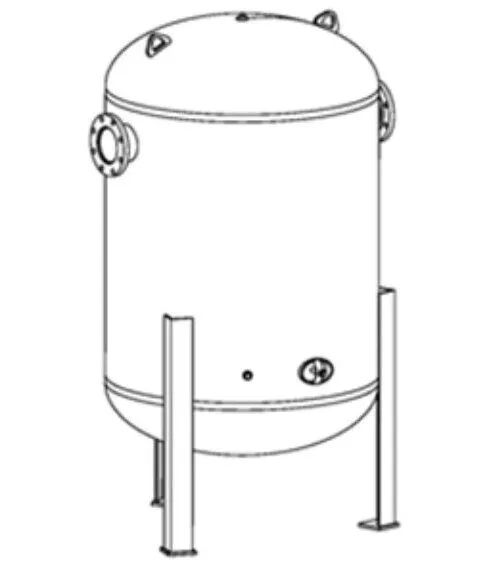Essential Differences between Storage Tanks and Surge Tanks
On this page
In fluid storage and handling systems, storage tanks and surge tanks play a crucial role. They not only undertake various tasks in industrial applications but also contribute significantly to the system due to their unique designs and functions. Storage tanks primarily focus on the storage of materials, ensuring the long-term supply of liquids or gases; whereas surge tanks are dedicated to the regulation and stabilization of fluids, safeguarding the smooth operation of the system. Understanding the functions, design features, and differences between these two types of equipment is essential for optimizing system performance and ensuring safe operation.
Storage Tank Functionality and Design

Storage tanks are one of the key pieces of equipment in industrial systems, primarily used for the storage of liquids or gases. Their design and functionality not only affect the stability of material supply but also the overall efficiency and safety of the system. The following will explore the main functions of storage tanks and their design characteristics in detail.
1. Main Functions of Storage Tanks
Long-term or Short-term Storage: Storage tanks are used for the long-term storage of crude oil, finished products, chemicals, etc., and can also be used for short-term storage of certain fluids to manage inventory.
Stabilized Supply: The storage function of tanks ensures a continuous supply of materials during peak demand or when supply is insufficient.
2. Design Features of Storage Tanks
Capacity and Structure: Storage tanks typically have large capacities, and their volume is determined based on storage requirements. Types include vertical, horizontal, and spherical tanks, each chosen based on the application and material characteristics.
Material Selection: Anti-corrosive materials are selected based on the liquids or gases being stored, such as anti-corrosive coatings or special alloy materials, to ensure the durability of the tank.
Additional Features: Insulation layers may be equipped to maintain a stable storage environment when material temperature control is necessary. Agitation devices are used to prevent material settling or to ensure uniformity, maintaining material quality and stability. Ventilation and cooling systems prevent material evaporation or overheating, ensuring a stable storage environment.
Safety Facilities: Safety valves and pressure relief devices prevent overpressure and leakage, protecting the tank and its surroundings. Level monitoring systems provide real-time tracking of the liquid level inside the tank to prevent overflow or drying out.
Surge Tank Functionality and Design

Surge tanks are a critical component of industrial systems, primarily used to stabilize and regulate fluid flow. They play a significant role in various industrial applications, especially in situations requiring a smooth fluid supply and the reduction of system shocks. The following will explore the main functions of surge tanks and their design characteristics in detail.
1. Main Functions of Surge Tanks
Pressure and Flow Regulation: Surge tanks absorb pressure fluctuations or flow variations in the system, ensuring the stable operation of downstream equipment and processes.
Balancing Supply and Demand Differences: By regulating flow and pressure, surge tanks balance differences between supply and demand, preventing instantaneous flow changes from impacting the system.
2. Design Features of Surge Tanks
Capacity and Structure: Surge tanks generally have smaller capacities, but their design focuses more on fluid regulation and pressure absorption. The internal structure is complex, considering factors such as pressure changes, fluid flow, and reaction time.
Material Selection: Materials must be capable of withstanding system pressure fluctuations to ensure long-term stable operation. Anti-corrosive materials are selected based on the nature of the fluid, but they may not require the long-term corrosion resistance needed for storage tanks.
Differences Between Storage Tanks and Surge Tanks
Although both storage tanks and surge tanks involve the storage and regulation of fluids, their design purposes and structural differences are significant. It is generally not recommended to use surge tanks as storage tanks. The main differences are as follows:
1. Design Purpose
Storage tanks are for storing large quantities of liquids or gases, focusing on long-term or short-term material storage and supply.
Surge tanks are for regulating flow and pressure fluctuations in the system, focusing on fluid balance and system stability.
2. Materials and Structures
Storage tanks are designed with long-term storage safety in mind, using corrosion-resistant materials, equipped with ventilation, heating, cooling, and stirring devices.
Surge tanks focus more on absorbing pressure fluctuations and flow changes, and may not have the corrosion resistance and capacity required for long-term material storage.
3. Safety Devices
Storage tanks are equipped with comprehensive safety devices, including safety valves, pressure relief devices, and level monitoring, ensuring the safety of long-term storage.
Surge tanks, with their primary function of balancing and regulating, have fewer safety devices and are mainly used as part of the system rather than for independent storage.
4. Application Scenarios
Storage tanks are used for storing crude oil, finished products, chemicals, etc., requiring long-term stable storage.
Surge tanks are used to balance flow and pressure, ensuring smooth system operation, mainly serving as a regulatory part of the system.
While in some emergency situations, a surge tank might be temporarily used as a storage tank, this practice does not comply with design specifications and safety requirements. To ensure the normal operation and safety of the system, it is important to choose specially designed storage tanks for material storage, and surge tanks should continue to be used for their specific regulatory and buffering functions.
In summary, storage tanks and surge tanks each have unique functions and design requirements in fluid storage and handling systems. Storage tanks primarily focus on providing reliable long-term or short-term material storage to ensure stable supply and system efficiency. Surge tanks, on the other hand, are dedicated to the regulation and stabilization of fluid flow, protecting the stable operation of the system by absorbing pressure and flow fluctuations. Although the two may have overlapping functions in some cases, their design and application scenarios are distinctly different. Understanding these differences is crucial for optimizing system performance, enhancing safety, and selecting the appropriate equipment.

